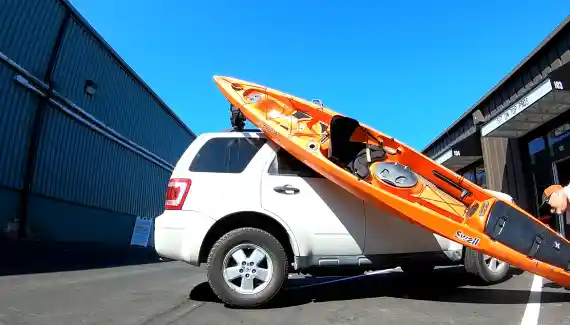Last Updated on March 19, 2023
Lifting a heavy kayak is both an intimidating and strenuous experience. That’s why it’s important to understand the proper methods for doing so safely and with maximum control. Lifting a kayak solo only requires strength, whereas strength and coordination are needed with a partner.
The Best method is to bend your knees and secure the cockpit’s front and back with one hand each. Carefully slide the boat up onto your thighs while keeping them bent. Then use one knee to support it as you lift overhead, positioning securely on its cradles in a single fluid motion.
Without the proper precautions, you may be at risk of back injury, foot or toe injuries, and damage to the vessel itself. Let’s explore how to safely hoist those hefty kayaks and the factors we must consider.
How To Lift A Heavy Kayak: Important Factors

Before attempting to lift a heavy kayak, it is important to consider several factors that may affect how it can be safely and efficiently lifted. These considerations include the size, weight, type of kayak, physical limitations, terrain, and environment.
1. Size and Weight of the Paddle kayak:
Knowing the size and weight of a kayak before attempting to lift it is essential for safety reasons. The average kayak is a lightweight vessel, spanning over 12 feet in length and just under 2.5 ft wide for optimal mobility on the water.
Depending on the type of kayak, it may range anywhere from 30-100 pounds or more. It tips the scales at an impressively low 63 pounds, making it easy to transport from the lake edge to open waters.
If looking for a lightweight option, fiberglass and inflatable models can be two viable options. On the other hand, a wooden or plastic kayak will tend to be heavier. If the kayak is too large or heavy for a person’s capabilities, then they should seek assistance from someone else.
One should also consider any gear they are bringing along, such as fishing tackle, camping equipment, or extra paddles, which can add even more weight in total. Furthermore, using a large tandem kayak or outfitting one with multiple seats will factor in when making calculations around weight limits.
2: Type of Kayak
The type of kayak you own can also play a role in determining how best to lift it safely and effectively. Different types of kayaks vary in weight, length, width, shape, center of gravity, and buoyancy, which all need to be considered when figuring out how best to lift them.
Sit-In Kayak:
Sit-in kayaks usually range from 8 to 14 feet long and 25 to 60 pounds in weight. The length affects the kayak’s stability, while the weight makes it easier or harder to carry or move around.
Sit-On-Top Kayak:
Sit-on-top kayaks typically range from 8 to 16 feet long and 35 to 70 pounds in weight. As with sit-in kayaks, the length affects stability, and weight affects transportability.
Recreational Kayak:
Recreational kayaks range from 8 to 12 feet long and 20 to 45 pounds in weight. These are generally lighter than other kayaks, making them easier to transport. However, they can still be fairly bulky depending on the model, making it more difficult for smaller individuals to lift them alone.
Touring Kayak:

Touring kayaks usually range from 10 to 17 feet long and 40 to 80 pounds in weight. These are generally heavier than other types of kayaks due to their larger size and additional features designed for extended trips on open water.
Inflatable Kayak:
Inflatable kayaks come in a variety of sizes ranging from 7 – 15 feet long and 20 – 45 lbs in weight when fully inflated. An inflatable kayak is usually lightweight when fully inflated and easy to lift and carry.
Fishing Kayak:
Fishing kayaks are typically 12 feet long and 50–80 pounds in weight though they may be longer or heavier depending on the model chosen. Any added accessories like rod holders or fishing crates add more weight and make them heavier fishing kayaks for the user afterward.
Sea Kayak:
Sea kayaks are usually long and narrow and can measure up to 20 feet in length with a width ranging from 22-24 inches. Their typical weight ranges from 40-90 pounds for single person models. However, those designed for two people can weigh up to 150 pounds.
River Kayak:
River kayaks typically range from 10-14 feet in length and a width of 24-32 inches. Their typical weight range is between 30-60 pounds depending on the model. But, some of them can be heavier if made out of more durable materials.
Tandem Kayak:
Tandem kayaks range from 12-17 feet long, with a width usually measuring 28-38 inches wide. Depending on the model, they can weigh anywhere between 50-120 pounds, so keep that in mind if you plan to lift one by yourself since they may require two people to transport them.
Modular Kayak:
They typically range between 8-12 feet long and a width between 27-35 inches wide. Their weight will depend on what material was used but usually is around 40-70 pounds depending on the number of pieces that make it up.
3. Physical Limitations:

Individuals who attempt to lift a heavy kayak must understand their own physical limitations, so they do not strain themselves when doing so. Lifting any object can strain one’s back if done improperly.
Therefore, individuals must know their own strength levels and practice proper form when lifting objects in general, regardless of size or weight. If multiple people are involved in a single lift, then each participant should utilize their strengths according to their individual capabilities.
Strong-bodied individuals bear most of the weight. A less strong individual focuses on maintaining balance to avoid any potential injuries or strains during lifting or transportation processes.
4. Terrain and Environment:
Any terrain can be challenging when transporting a heavy kayak, making it important to consider the surface texture, inclines within their environment, and other conditions. For example, wet or slippery surfaces could create hazards, while soft surfaces may make navigation difficult due to sinking with each step.
Heavier kayaks will require more energy output while moving them. It is also good to know the center of gravity of a specific model as this will help determine where it should be lifted from so it can be more easily maneuvered around with minimal strain on those carrying it.
To avoid any potential risks and difficulties associated with these environmental factors, assessing the terrain beforehand and taking appropriate actions is essential. This will help ensure that success can be achieved in transporting the kayak both safely and efficiently.
During kayak transportation processes, high winds can create hazardous conditions, and sudden shifts in direction cause a challenge when transporting substantial weight. It is essential to take these risk factors into account for successful delivery.
5. Availability of Additional Gear:
When lifting a heavy kayak, having the right gear can make all the difference. Kayakers should consider purchasing additional items such as a yoke or roof racks with rollers to help maneuver and transport their vessel.
They should also purchase carry straps specifically designed for carrying a heavy kayak. Also can buy kayak carts or trailers if they plan on taking their vessel places without having to lift it themselves. All the equipment will ensure that lifting and transporting a heavy kayak is much easier and safer than trying by hand.
How To Lift A Heavy Kayak: Best 2 Methods without Getting Injury

Learning how to lift a heavy kayak can be challenging for beginners. There are 2 methods available, depending on your preferences and the environment you are working with. Knowing the right techniques and tips can help you easily lift and transport your kayak.
Method 1: Lifting Kayak onto the Shoulder with Bare hand
- Start by standing with your feet shoulder-width apart and facing the kayak.
- Squat down and grab the kayak’s cockpit rim with both hands.
- Lift the kayak onto one thigh, then slide your other arm under the kayak to support it.
- Stand up slowly, keeping your back straight and your core engaged.
- With the kayak balanced on your thigh and arm, move it onto your shoulder.
- Adjust the kayak’s position on your shoulder until it feels comfortable and secure.
Method 2: Lifting Kayak With Other Person or Assistance
- Find a helper who can assist you in lifting and carrying the kayak. Ensure that both individuals have a firm grasp of the kayak.
- Utilize proper techniques for lifting a heavier kayak, distributing the weight evenly throughout both people’s bodies. Squat down while keeping your back straight and use your legs to lift rather than your back or arms.
- Always keep the kayak in front of you when carrying it, as this will help prevent any injuries from occurring due to sudden movements or slipping of the boat. Gripping both sides firmly will also help prevent any slips from occurring during transit.
- When approaching an incline or decline, ensure that you are both walking at a consistent pace and not overexerting yourself by rushing too quickly over an uneven surface.
- Ensure that you arrive at your destination safely before releasing your grip on the kayak and setting it down carefully in its resting place.
How Do You Lift a Kayak onto a Roof Rack?
Lifting a kayak onto a car roof rack requires extreme caution. Below are some professional tips to help you safely lift your kayak yourself using a kayak rack and avoid potential injuries:
- Park your vehicle on level ground, and position it so the rear end faces the spot where you will lift the kayak onto the roof.
- Bend your knees slightly and grab the cockpit of the kayak securely with both hands.
- Slide onto your thighs while maintaining a good grip on the kayak, then slowly lift one knee up to support it while keeping your back straight.
- With both hands still securely gripping the cockpit, slowly lift the kayak over your head and place it carefully onto the roof rack system, such as cradles located on top of your roof rack crossbars.
- Make sure to center the kayak between both cradles for proper support and balance before securing it with straps or other fastening devices for extra stability during transport.
- If you find that you are unable to lift your boat onto the cradles safely, ask a friend for help or use resourceful ideas such as sliding the kayak up onto the j rack with a big piece of carpet or using foam pool noodles to secure kayak onto bars of roof rack (e.g., two under each side).
- Double-check that all straps, buckles, and fastening devices are properly tightened before driving off with your loaded boat.
How Do You Lift a Kayak onto a Cart?

Kayak carts can eliminate the hassle of transporting your kayak to and from shore, but how do you get it on there? We’re ready to provide easy steps for lifting your boat onto a kayak trailer or cart with minimal effort.
1. Gather the necessary materials and safety equipment. You will need a kayak cart, sturdy gloves, and an appropriate lifting device such as a hand truck or ratchet strap.
2. Position the kayak cart close to the kayak, ensuring its wheels are stable on the ground. Place the straps of the lifting device underneath your kayak, ensuring that they are securely attached to it.
3. Ensure you wear sturdy shoes or boots with good grip to prevent slipping during lifting operations. Put on your gloves to protect your hands from getting injured during heavy lifting operations.
4. Bend your knees slightly and keep your back straight while using your legs to lift up the kayak onto the cart and slide it onto its designated place on the cart bed. Ensure it is secured properly by tightening all clamps or belts, if any are provided with the cart.
5. Adjust your posture while pushing or pulling the laden kayak cart so that the strain is equally distributed between both arms and legs. In long-term use cases, it avoids injury due to muscle fatigue and incorrect body alignment.
Can One Person Lift a Kayak?
One person can lift a kayak depending on its size and weight. Smaller, lighter kayaks are easy to manage to carry alone. A larger one made of heavier materials may require a strong person or two people to do so safely.
Additionally, the “hip flip” technique can be used with smaller kayaks whereby the individual places the kayak on its side and lifts it onto their hip before flipping it onto their shoulder.
Can a Heavier Person Lift a Kayak?
A heavier person can lift a kayak if they have adequate physical strength and know proper lifting techniques to prevent injury, such as lifting with their legs instead of their back.
If needed, tools like kayak carts or racks can help support the load and make it easier to transport. In some cases, assistance from another person may be necessary for safety reasons.
Do You Carry a 10 Foot Kayak?

You can carry a 10 foot kayak with lightweight yet durable construction designed for easy transport. Adjustable footrests can also provide comfort during long trips, but it is important to remember to lift with your legs rather than your back to reduce the risk of injury.
Wearing protective clothing such as gloves or goggles might also prove helpful when carrying larger vessels like this.
Safely and Easily Lift Your Kayak
Lifting a heavy kayak can be nerve-wracking, but it can be done safely and without any issues with the right knowledge and precautionary steps. It is important to consider the size and weight of your kayak and your physical limitations before attempting to lift it.
Terrain and environment may also require additional gear or equipment for safe lifting. If all of these elements are considered, you can lift your kayak without risk of injury or damage.
